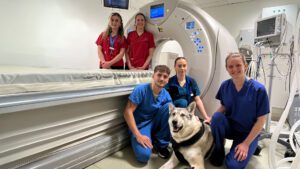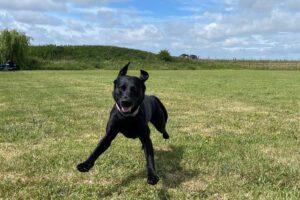Methods
A retrospective multicentre study was performed, including dogs examined from 2010–2015 at five veterinary referral hospitals (Davies Veterinary Specialists, Herts; Chestergates Veterinary Referral Hospital, Chester; Fitzpatrick Referrals, Surrey; Stone Lion Veterinary Hospital, London, and the University Hospital for Companion Animals, Copenhagen). Dogs with magnetic resonance imaging (MRI) changes suggestive of a cerebellar ischaemic stroke were eligible for inclusion. Inclusion criteria were: a full medical record including history, physical and neurological examination, complete blood count, and serum biochemistry. Results of the cerebrospinal fluid analysis were included, when available. Exclusion criteria were: progression of neurological deficits beyond 24 h, any presence of concurrent non-cerebellar strokes, and treatment with immunosuppressive doses of corticosteroids. All neurological examinations were performed by a DipECVN, a resident working under the supervision of a DipECVN, or by a DVM with a PhD in veterinary neurology. The study was approved by the Local Administrative and Ethics Committee, Department of Veterinary Clinical and Animal Sciences, Faculty of Health Sciences, University of Copenhagen (Permission no. 1 N/2013).
Results
Twenty-three dogs, 13 females and 10 males with a median age of 8 years and 8 months, were included in the study. The Cavalier King Charles Spaniel (n = 9) was a commonly represented breed. All ischaemic strokes were located to the vascular territory of the rostral cerebellar artery including four extensive and 19 limited occlusions. The most prominent neurological deficits were gait abnormalities (ataxia with hypermetria n = 11, ataxia without hypermetria n = 4, non-ambulatory n = 6), head tilt (n = 13), nystagmus (n = 8), decreased menace response (n = 7), postural reaction deficits (n = 7), and proprioceptive deficits (n = 5). Neurological signs appeared irrespective of the infarct being classified as extensive or limited. All dogs survived and were discharged within 1–10 days of hospitalisation.
Conclusion
Dogs affected by rostral cerebellar ischaemic stroke typically present with a collection of neurological deficits characterised by ataxia, head tilt, and nystagmus irrespective of the specific cerebellar infarct topography. In dogs with peracute to acute onset of these neurological deficits, cerebellar ischaemic stroke should be considered an important differential diagnosis, and neuroimaging investigations are indicated. Although dogs are often severely compromised at presentation, short-term prognosis is excellent and rapid clinical improvement may be observed within the first week following the ischaemic stroke.
Summary
In dogs with ischaemic stroke, a very common site of infarction is the cerebellum. The aim of this study was to characterise neurological signs in relation to infarct topography in dogs with suspected cerebellar ischaemic stroke and to report short-term outcome confined to the hospitalisation period. A retrospective multicentre study of dogs with suspected cerebellar ischaemic stroke examined from 2010–2015 at five veterinary referral hospitals was performed. Findings from clinical, neurological, and paraclinical investigations including magnetic resonance imaging were assessed.











